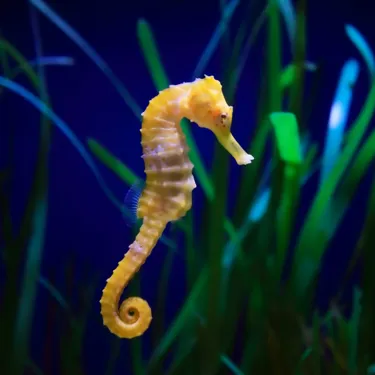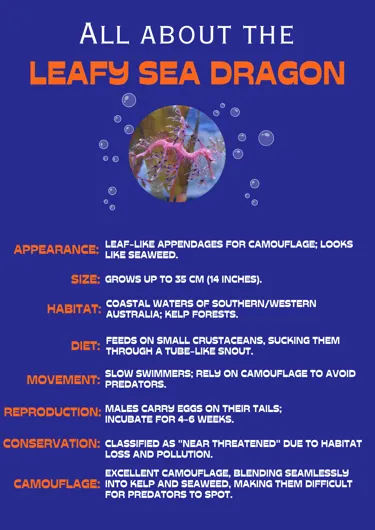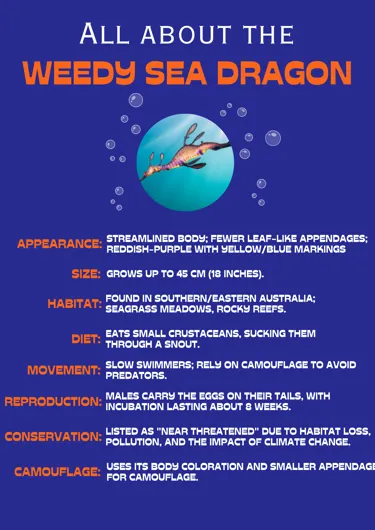10 Amazing Seahorse Facts You Need to Know
- Sunday 9th June 2024

At SEA LIFE Melbourne, the underwater realm is filled with fascinating creatures, but few are as captivating as the seahorse. With their unique appearance and remarkable adaptations, seahorses have long intrigued marine enthusiasts and casual visitors alike. These charming fish offer a glimpse into the wonders of the ocean. Discover some incredible facts about these elusive creatures and see why they hold a special place in the hearts of those who visit SEA LIFE Melbourne.
Key Takeaways
- Seahorses are unique fish with fascinating adaptations, including males carrying fertilised eggs in a brood pouch until they hatch!
- These charming creatures utilise incredible camouflage techniques, changing colours and blending seamlessly into their surroundings to avoid predators.
- Although they are extraordinary predators, seahorses face significant threats from overfishing and habitat destruction, making conservation efforts essential for their survival.
Seahorses are Fish Too!
Seahorses, despite their unusual appearance, are indeed fish. Belonging to the family Syngnathidae and the genus Hippocampus, they share this classification with other marine species like pipefish and sea dragons. Their unique physical characteristics, such as a horse-like head, monkey-like tail, and armour-like plates, set them apart from other fish species.
These fascinating creatures primarily inhabit tropical and temperate coastal waters, often found in seagrass beds, coral reefs, and mangrove roots. With a lifespan of approximately three years in the wild, seahorses have adapted to their environments in remarkable ways. Their swim bladders help them achieve buoyancy, while their independent eye movement allows them to scan for prey and predators simultaneously.
The Romantic Seahorse Dance
Seahorses are known for their romantic courtship dances, which are a sight to behold. Most seahorse species are monogamous, often forming lasting bonds with their mates. Every day, male and female seahorses perform elaborate courtship displays that involve circling each other, changing colour, and even holding tails.
These dances can last for extended periods, sometimes up to an hour, before mating. The colour changes observed during these rituals are not just for show; they serve as a form of communication between the partners and can also be used during territorial disputes.
The romantic seahorse dance is a beautiful example of the deep connections these creatures form with each other.
Nature's Unique Fathers
Unlike most other fish species, it is the male seahorses that carry the fertilised eggs in a specialised brood pouch until they hatch. This unique reproductive method ensures that male and female seahorses, including the pregnant male seahorse, and the female seahorse share the responsibilities of raising their young.
The gestation period for seahorse embryos typically ranges from two to four weeks, during which the male provides oxygen and nutrients to the developing eggs. When it’s time for the baby seahorses to be born, the male seahorse undergoes a birthing process that can last up to 12 hours, releasing anywhere from a few dozen to over 1,000 newborn seahorses.
Unfortunately, the survival rate for baby seahorses is quite low, with only about 0.5% reaching adulthood due to high predation rates and environmental challenges. Despite these odds, the dedication of male seahorses to carrying and caring for their offspring is a testament to their unique role in the marine world.
Poor Swimmers with a Prehensile Twist
Seahorses are among the slowest-moving fish species, relying on their tiny dorsal fin and tiny pectoral fins to propel them through the water. These fins beat rapidly, but their small size makes seahorses poor swimmers. To compensate for their lack of speed, seahorses have developed prehensile tails that allow them to grasp onto objects like coral or seaweed, anchoring themselves in place.
This adaptation is crucial for their survival in the often turbulent waters of their habitats. Their tails help seahorses anchor themselves, providing stability and preventing them from being swept away by currents. This prehensile twist is a perfect example of how these unique creatures have adapted to their environments in ingenious ways.
Constant Grazers
Seahorses have a unique feeding strategy that involves constant grazing. They lack stomachs, so they must eat frequently to sustain themselves. Their diet consists mainly of tiny fish and plankton, which they consume through a suction mechanism similar to a vacuum cleaner. This method allows them to capture prey with precision and efficiency.
With their S-shaped bodies and curved heads, seahorses are well-adapted for hunting and feeding. Their flexible necks enable them to extend their strike range by 20%, making them effective predators despite their slow movements. On average, an adult seahorse eats 30-50 times a day, highlighting their need for constant nourishment.
Masters of Camouflage
Camouflage is a vital survival tool for seahorses. These creatures can change colour rapidly to blend into their surroundings, making them virtually invisible to predators and prey alike. This ability is especially useful during courtship displays, where colour changes serve as a form of communication between partners.
Seahorses also mimic the movements of seaweed to evade predators and enhance their feeding efficiency. Their long necks and independent eye movement allow them to stealthily reach out and capture prey without drawing attention. The unique upright posture of seahorses further aids in their camouflage, helping them blend seamlessly into seagrass beds and other environments.
Diverse Seahorse Species
There are over 40 recognized seahorse species, each with its own unique characteristics and adaptations. The Australian big-bellied seahorse, for example, can grow up to 11.8 inches, while the tiny pygmy seahorse measures less than an inch in length. This incredible diversity makes seahorses one of the most fascinating groups of marine species.
Seahorses are typically found in shallow weedy areas, especially eelgrass beds, where they can find plenty of food and shelter. The Leafy Sea Dragon, a relative of the seahorse, is known for its stunning leaf-like appendages that help it blend in with seaweed and kelp forests. This incredible camouflage makes it almost indistinguishable from its surroundings.
The variety of seahorse species underscores the adaptability and resilience of these unique creatures. From the tropical waters of the Pacific seahorse to the temperate coasts of Australia, the seahorse species range has allowed them to thrive in a wide range of environments. This diversity is a testament to their evolutionary success and the importance of conserving their habitats.
Threats to Survival
Despite their fascinating adaptations, seahorses face significant threats to their survival. Human activities such as overfishing and habitat destruction have had a devastating impact on seahorse populations. An estimated 37 million seahorses are harvested annually from coastal waters, primarily due to indiscriminate fishing methods.
The demand for seahorses in traditional Chinese medicine also drives significant levels of exploitation. Seahorses are often used as folk remedies, and Southeast Asia and West Africa are the primary regions for seahorse exports. Sadly, more than half of the seahorses captured for trade die before they even reach the market.
Despite international protection efforts, many seahorse species remain threatened due to ineffective conservation measures. Reducing viable habitats through pollution and coastal development further endangers their populations. Conservation initiatives, such as those led by Project Seahorse, are crucial in safeguarding these remarkable creatures for future generations.
The Evolutionary Journey of Seahorses
The evolutionary journey of seahorses is as fascinating as their current existence. It is believed that seahorses descended from pipefishes around 25 million years ago, coinciding with tectonic activities that formed shallow seagrass habitats. This evolution allowed seahorses to adapt to their unique environments, developing traits such as prehensile tails and elaborate camouflage.
These adaptations have enabled seahorses to thrive in a variety of marine environments, from tropical coral reefs to temperate seagrass beds. The evolutionary success of seahorses is a testament to their resilience and the incredible diversity of life in our oceans.
Understanding their evolutionary history helps us appreciate the complex interplay of factors that have shaped these remarkable creatures.
Seahorses at SEA LIFE Melbourne: Leafy and Weedy Seahorses


Shared Facts
- Unique Reproductive Role: In both species, it is the male that carries and cares for the eggs until they hatch, which is rare among fish.
- Protection Status: Both species are protected under Australian law, making it illegal to capture or disturb them.
- Lifespan: Both leafy and weedy sea dragons can live for up to 10 years in the wild under favourable conditions.
Want to meet our sea dragons? Book now to see all of our sea creatures at SEA LIFE Melbourne today! Book here!
Frequently Asked Questions
Why are seahorses considered poor swimmers?
Seahorses are considered poor swimmers because they depend on their small dorsal fins for movement, which only gives them limited propulsion. This unique swimming style makes them one of the slowest fish!
How do seahorses camouflage themselves?
Seahorses are incredible at camouflaging themselves by rapidly changing colour, perfectly mimicking seaweed and their surroundings to dodge predators! It's an amazing survival strategy in their underwater world!
What makes male seahorses unique in the animal kingdom?
Male seahorses are truly remarkable because they carry fertilised eggs in a special brood pouch, a responsibility usually held by females in the animal kingdom! This incredible role makes them stand out in the reproductive process!
What are the main threats to seahorse populations?
Absolutely! The main threats to seahorse populations come from overfishing, habitat destruction, and their use in traditional medicine, with around 37 million seahorses harvested each year. Protecting these amazing creatures is essential for their survival!
What are baby seahorses called?
Baby seahorses are called fry. When they are born, they are tiny, independent, and fully formed versions of their parents. Seahorse fry must fend for themselves from the moment they hatch.
How long do seahorses live?
- Seahorses can live up to about 1 to 5 years in the wild, depending on the species and environmental conditions. On average, most seahorses have a lifespan of around 3 years.
- Sea dragons, such as the leafy sea dragon and weedy sea dragon, typically have a longer lifespan. In the wild, they can live for about 6 to 10 years, and in captivity, with optimal care, they may live even longer, sometimes up to 15 years.